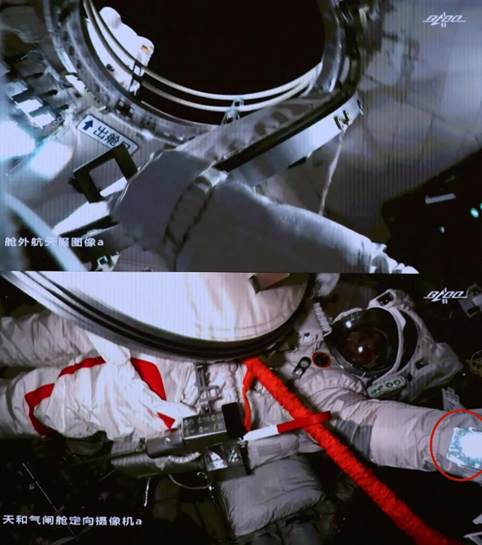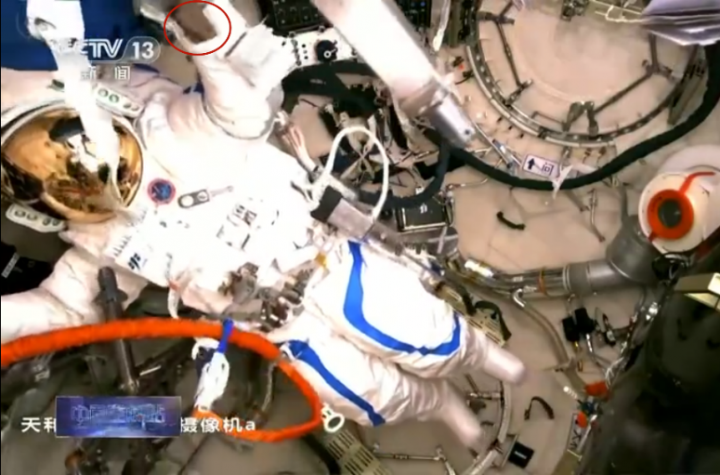HIT All Media (Sources: Text from China Manned Space Engineering Office; pictures from CCTV news)
At 14:57, July 4, 2021, after seven hours of Extravehicular Activity (EVA), the crew of China’s Shenzhou-XII taikonauts carried out all the tasks of the EVA in collaboration. When taikonauts (the Chinese name for astronauts) Liu Boming and Tang Hongbo made a safe return to Tianhe (River in the Heaven, also a Chinese name for the Milky Way) core module of Tiangong (Palace in the Heaven) Space Station, it marks a full success of the first EVA of taikonauts at the stage of China’s Space Station.
This is the second EVA of Chinese taikonauts after the Shenzhou VII crewed mission in 2008, and also the first EVA in the space station stage. The Shenzhou XII taikonauts, Liu Boming and Tang Hongbo, were equipped with a new generation of EVA spacesuits, named Feitian (Flying in the Heaven), independently developed with Chinese technology. The technical support from HIT’s Metal Composites and Engineering Research Center, School of Materials, led by Professor Wu Gaohui, and the Institute of Fluid High Pressure Forming Technology made important contributions to the taikonauts’ EVA spacesuits so that they could work with an extended time on the exterior portion of the space station.
A reflector is an important component of the EVA spacesuit, playing a role in expanding a taikonaut’s scope of vision. It has extremely special conditions of usage, for which purpose it needs to be ultra-thin and ultra-light, reflecting more than 98% of visible light spectrum; meanwhile, it needs to maintain its optical norms when facing radiation, extreme temperatures, drop impact, and hard point scratching. Prof. Wu Gaohui’s team adopted a technique with optical grade aluminum-based silicon carbide (SiC/Al) composite material, for which they have proprietary intellectual property rights. The technique breaks the limit of a traditional reflector’s diameter-thickness ratio, setting an ultrathin record of 1:25. With special stabilization process and coating treatment, the technique met the demand in design and supported the success of Taikonauts’ extravehicular activities.
An EVA spacesuit is actually a miniature spaceship worn on a human body. The oxygen pipeline in the life support system is a “lifeline” that protects the taikonauts from the dangers of being outside a vehicle while in space. The pipeline needs to be highly reliable. Different from Shenzhou-VII’s 19 minutes EVA, the Shenzhou-XII EVA lasted seven hours. It meant not only a dramatic increase in the duration, but much more increased risks of being outside. The pipeline made with traditional technique has a large number of welded seams, which relates to low reliability that could bring potential dangers to the life of taikonauts. The Institute of Fluid and High Pressure Forming Technology, School of Materials, HIT, worked in collaboration with China Astronaut Research & Training Center and China Academy of Launch Vehicle Technology to make the technological breakthrough. Over two years of hard work, from the prototype phase to the flight model phase, the team adopted their invention that used double-adjustment hot dielectric forming technology to achieve key innovations, e.g., wall thickness uniformity control. They finally developed a comprehensive structure of special-shaped oxygen delivery tubes, which eliminated all the welded seams in a traditional structure. Their work made significant contributions to the protection of taikonauts’ lives during the extended time of conducting EVA.

Photo of the taikonaut wearing an EVA spacesuit reflector out of the space station (from China Manned Space Engineering Office)

Photo of the taikonaut wearing an EVA spacesuit reflector out of the space station (screenshot from CCTV news)


